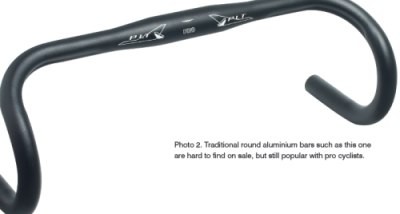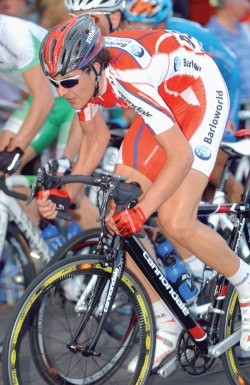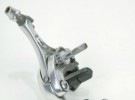There are now literally hundreds of different handlebars on the market. Which bar is right for you? We asked positioning expert Steve Hogg to steer us through the handlebar maze.
Handlebars are available in a bewildering number of ‘anatomic’ shapes as well as the now less common ‘round’ bars. When used to describe handlebars, ‘anatomic’ refers to any bar which has been shaped in some way to better fit your hand. Carbon bars and stems are becoming common and the vast majority of these are anatomic shapes (Photo 1). However, after glancing at pro team bike specs, it seems that the majority of pros use ‘old fashioned round aluminium bars (Photo 2). We started by asking Steve about this.
Bicycling Australia: Why the preponderance of aluminium bars and stems amongst pros?
Steve Hogg: At this stage in the development of carbon bars and stems; carbon bars offer negligible weight savings and many carbon stems are heavier than their aluminium counterparts. I’m sure that www.weightweenies.starbike.com will list individual exceptions, but across the board what I’ve said is accurate. So there is little or no weight advantage to be had with carbon. Aluminium is a proven material in this application having been in widespread use for bars and stems since the late 1950’s or early 1960’s. It is a developed enough material in this application to be almost idiot proof. Carbon is not at that stage yet. Carbon markets well as high tech and exotic, and manufacturers oblige by producing items for those susceptible to tech appeal. And good luck to them. To summarise, carbon offers no meaningful weight savings, is often heavier if bars and stems are considered together, is more expensive and does not tolerate mechanical ineptitude nearly as well as aluminium. That’s why aluminium is the overwhelming choice amongst pro teams —at the moment. With advances in ‘productionising’ composite materials at reasonable cost, I would have to consult a crystal ball to say whether that will still be the case in 10 years time. 

BA: What’s your view on round bars versus anatomic bars?
SH: For mine, a good round bar beats an anatomic bar almost every time. That said there aren’t many good round bars. We need to consider what it is that we need from a handlebar in a positional sense to make the best individual choice.
BA: What does that involve; width and shape?
SH: Ideally the width needs to be wide enough on road bikes for the rider’s hands to be slightly wider than his shoulder centres with hands in drops.
As far as shape goes, a good bar should have:
• A shape that allows good hand placement in the drops for sustained efforts.
• Good hand placement for off the seat sprinting.
• Good hand placement for short, anaerobic efforts on the seat.
• A shape that allows the rider to reach the brake levers with ease when placing the hands in the drops, while still allowing the brake levers to be as high as a given rider needs for good comfort and minimum bend of the wrist when holding the brake hoods, whether riding on or off the seat.
• That allows good hand placement for the hands on the top of the bars
BA: That’s a long list. What shape of bar gives all of that?
SH: Before I answer that question properly, I need to define several descriptive terms. Each of these terms describes features of a bar as measured when the rearmost part of the drops are horizontal, as though that part of the bar was placed flat on the floor. That doesn’t’t mean that the bars have to be ridden with the rearmost part of the drops horizontal; it is just a useful measuring convention.
BA: Why do you think that a round bar is a better bet for most riders?

SH: Apart from some exceptions, most anatomic bars offer only one hand position in the drops. Some have a steeper grip section than others. If your hand grip section of an anatomic bar is more vertical, then naturally your hand has to be at a more vertical angle to grip it. As a consequence, your elbows and upper body have to be lower than when you have a more horizontal grip at the same bar height, as measured from the front axle. This style of bars is a poor choice for off the seat sprinting because the vertical hand angle is not a good one with which to resist the downward force of the opposite leg. See photo 3. Deda anatomic bars are an example of this, though there are plenty of similar examples in other brands. They have steep grip angle. Rearward of this, where it is natural to grip the bars in an off the seat sprint, Deda’s have pronounced kink right in the middle of that point. Yes, that kink can be filled with padding and taped over to produce a more hand friendly curve, but why should we have to? See diagrams 6a and 6b. They’re not all bad though. Deda’s are one of the better anatomic bars of the last 10 years. Their drop minimum radius is quite open and their upper drop slope is flattish. If they changed that kink into a curve, they would be a near perfect anatomic bar for many people. Anatomic bars with a flatter grip angle, and there are plenty of them, are good for off the seat sprinting and sustained efforts with hands in drops, but most suffer from having a small drop minimum radius as a consequence of this.
That means that as the brake hood is raised further up the bar to a comfortable height for riding with hands on brake hoods, the brake lever moves further away; often too far away for all but the long fingered to reach. Many riders try to compensate for this by rotating the bars upwards to raise the brake hood height. When this is done though, the grip angle steepens, causing the rider to bend their wrists noticeably when off the seat. This often brings the wrists or lower forearms into contact with the top of the bar while the rider is sprinting off the seat. There are many, many variations on the themes of anatomic bars with flatter or steeper grip angles and some are a lot better than others. Some bar manufacturers have reduced the bar reach dimension to try and solve the problem of wrists contacting the bars. That approach doesn’t address the real problem, which is that many anatomic bars are poorly designed. Over the past few years, some designers have shortened the reach of anatomic bars to the point where many now have a reach of less than 80 mm. This has been in an effort to address problems of the type I have just described. In shortening the reach, the rider has to reach further to the bar tops because they need a longer stem for the same overall reach to the drops as they would have with a longer reach bar. I think the better solution would be to make the shape of bars more versatile in terms of where the shape of the single grip section of most anatomic bars dictates that the hands must be placed when in drops.
BA: What about round bars? Do they solve these problems?

SH: There aren’t many round bars left, but they are making a comeback of sorts. ‘Deep drop’ in pre STI / Ergo power lever days usually meant a bar drop of 150 mm to 170 mm. This allowed pros to have their brake hoods high, just as many do now, while still having a lower and more effective height for sprinting with hands in the drops when off the seat. The old style bars mated poorly with combined brake/gear levers, particularly Ergopowers, because if the hoods were at a sensible height, then with hands in drops it meant a large change in hand position to get to the gear lever for all but a few riders. The newer deep drop round bars, Deda Deep and Ritchey Classic have a bar drop of 145 mm or close to it, which largely solves that problem.
Better still, they have flattish upper drop slopes, particularly the Ritchey Classic, meaning that for a given hood height, their large minimum radius means that the brake lever is relatively easy reach from the drops. FSA make a deep drop bar as well but I don’t rate it so highly. It has a steep upper drop slope and consequently a smaller drop minimum radius than the Deda or Ritchey. The Deda Deep and Ritchey Classic shape allows a variety of grip angles which anatomic bars don’t in general. I think this is a plus and my major complaint against the majority of anatomic bars. The largest difference between the Deda Deep and Ritchey Classic is their respective bar reach. Deda measure 95 mm and Ritchey 82 mm in that dimension. This means that for a given position on the drops, the Ritchey will need a longer stem than the Deda’s. Both are available in 26.0 mm and 31.8 mm clamp diameters. In 31.8 mm, Deda’s are better for use with aero bars if that is a consideration, because the centre bulge extends further either side of the stem giving a wide clamping surface for the aero bar clamps. Other than that, I have no strong preference and am happy to let other factors determine which is better suited to a rider. Sadly, both of these bars are their manufacturer’s top of the line in quality and price. We are not going to see a strong resurgence until similar shape bars are available in heavier, meaning less expensive, versions.
BA: What about shallow drop bars?

SH: Shallow drop historically has meant a bar drop of 130 – 135 mm in the main and that is still the case today. Shallow drop bars are meant to be used by people who don’t have wide palms. The problem is that narrow palms often belong to riders with short fingers. A shallow drop bar by definition has a smaller drop minimum radius than a deep drop bar, meaning in turn that the problem of hood height versus easy reach to the brake levers from the drops often surfaces. A well designed anatomic bar is often preferable to a poorly designed shallow drop round bar for the narrow palmed, short fingered rider. It is in this area that Shimano, Campag and SRAM should reconsider their brake/gear lever designs slightly.
If I can buy a pair of $10 MTB brake levers with span adjustment (the distance from the lever to the bar), why can’t I do the same with a good quality STI, Ergo power or SRAM lever? All bars do the job at some level. I think that there has been a needless rush into the ever increasing complexity of shapes with anatomic bars. Whether it is marketing driven or the result of designers trying to solve a particular limitation of a bar shape without creating others, I don’t know. What I do know is that a well designed round bar is a more versatile answer to the problem of having human hands steer a bike than many of the anatomic bars that have been around over the past 10 years. I doubt that everyone will agree with that but as you have observed, the pros who spend more time on their bikes and use them more intensely than the rest of us, have voted with their hands in that direction.
 BA: Are there any anatomic bars that you favour?
BA: Are there any anatomic bars that you favour?SH: Yes there are. Some of the newer anatomic bars have very flat upper drop slopes and a curved single radius lower section without kinks. This means that while they do have a small drop minimum radius, the bend is positioned so high that brake lever positioning potential is good. Most riders will be able to reach the brakes easily with hands in drops while still being able to place hands on the brake hoods with unbent or only slightly bent wrists. The lack of a clearly defined grip section is a more versatile solution and is more like a round bar in terms of feel when placing hands in the drops.
BA: Can you give me some examples of these?
SH: Modolo Kaly in aluminium in a 90 mm reach, Modolo Curvissima in a much shorter reach, FSA K Force Compact and FSA Wing Pro Compact. There are others and more on the way from what I can tell. Many of these styles of high bend, bend flat upper drop slope aero bars have flat sections on top where the hands rest as well for greater comfort when your hands are on the bar tops. Technically these are all shallow drop bars with drops of 130 mm or less, but the combination of curved lower section and flat upper drop slope mean that even the largest hands will fit in the drops.
BA: So you aren’t against anatomic bars then?
SH: No. All bars do the job at some level but for the period that anatomic bars have been available, many of them seem to be designed to look funky rather than aiding rider comfort and ability to steer a bike.
Many of the shapes that have been around caused problems in these areas and many bars that subsequently solved these issues only did so by creating other problems. There are a lot of so-so anatomic bars still on the market but some really good ones have appeared recently and there are more on the way. There is enough variety in reach and depth of drop to keep most riders happy if they are selective and think about what they fit to their bike.
